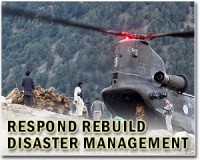| . |  |
. |
Washington (AFP) Feb 28, 2010 A combination of geography, comparative wealth and disaster readiness is why Chile's massive earthquake won't come close to Haiti's calamitous toll even though it was much stronger, experts say. Saturday's 8.8-magnitude quake, the seventh most powerful on record, struck central Chile some 325 kilometers (200 miles) south of the capital Santiago and 115 kilometers north-northeast of the second city of Concepcion. So far the death toll is over 700 and rising, although President Michelle Bachelet in announcing the newest figures warned the toll would still rise with hundreds of people remaining missing. Haiti, the poorest country in the Americas, was struck on January 12 with a 7.0-magnitude quake -- hundreds of times weaker than the one in Chile -- but the epicenter was just 24 kilometers from the overflowing capital Port-au-Prince. The most recent estimates put the toll there at over 220,000 dead, with President Rene Preval warning the final figure could reach 300,000, making it the worst natural disaster in modern history. Seismically speaking, comparisons between the tremors are irrelevant because the situations at their fault lines are so different, experts said. But put in geographic context, the two earthquakes show how events of different strengths at varying distances from densely urban areas can have vastly different outcomes. The epicenter of Chile's earthquake was 35 kilometers below the ocean floor, with the seabed absorbing a large portion of the shock -- although it did prompt a tsunami that threatened the entire Pacific region. At a depth of only 10 kilometers, it was the Haiti quake's shallowness that proved so catastrophic, according to experts. This proximity to the surface amplified the vibrations and caused far more damage to densely-packed urban areas near the Haitian capital. The epicenter of Chile's quake was almost five times farther away from the second city of Concepcion than Port-au-Prince was to Haiti's quake. "The difference between the Chile quake and Haiti was not only that the epicenter of the Haiti quake was closer... but also that Chile was better prepared than Haiti for a quake of this magnitude and intensity," Roger Bilham, a geology expert at the University of Colorado, told AFP. Because Chileans live on an active fault line, with the experience of the largest recorded earthquake in history, the South American country was far more ready for a major seismic event than Haiti -- relatively unused to such quakes. Since May 1960's record 9.5-magnitude quake that left over 2,000 dead, successive Chilean governments have ensured sensible moves towards robust construction standards. While Saturday's quake still constitutes a major disaster, Chile's widespread adoption and enforcement of modern, seismic-resistant building practices "has mitigated the potential for devastation," according to US risk modelling firm EQECAT. Sustainable building group Architecture for Humanity noted the differences between construction in the two countries by saying "stronger building codes and location/depth of the epicenter" resulted in less damage in South America. Following Haiti's quake, engineering experts blamed lax building standards in the Caribbean nation for having exacerbated the disaster. When the quake struck, apartment blocks and smaller homes simply crumbled to the ground, trapping thousands under rubble and burying thousands more alive. "The quality of construction in Haiti, even in buildings that are supposedly engineered construction, is not good at all," Farzad Naeim, president of the board of directors of the Earthquake Engineering Research Institute (EERI), told AFP at the time. From photographs he saw of the devastation in Haiti, Naeim said many of the larger buildings were built using non-ductile concrete. This was described in a report presented at the World Conference on Earthquake Engineering in Beijing in 2008 as "arguably... the greatest seismic life safety hazard in many urban centers worldwide because of the collapse potential."
Share This Article With Planet Earth
Related Links Bringing Order To A World Of Disasters A world of storm and tempest When the Earth Quakes
 World pledges aid to quake-hit Chile
World pledges aid to quake-hit ChileParis (AFP) Feb 28, 2010 The United States and Europe vowed to come to Chile's aid as relief workers rushed to the Western hemisphere's second enormous earthquake in seven weeks. But the Latin American country, reeling from the deaths of at least 300 people and a trail of destruction caused by Saturday's 8.8-magnitude quake, appealed for foreign donors to wait until the scale of the task is clear. "We are very g ... read more |
|
| The content herein, unless otherwise known to be public domain, are Copyright 1995-2010 - SpaceDaily. AFP and UPI Wire Stories are copyright Agence France-Presse and United Press International. ESA Portal Reports are copyright European Space Agency. All NASA sourced material is public domain. Additional copyrights may apply in whole or part to other bona fide parties. Advertising does not imply endorsement,agreement or approval of any opinions, statements or information provided by SpaceDaily on any Web page published or hosted by SpaceDaily. Privacy Statement |